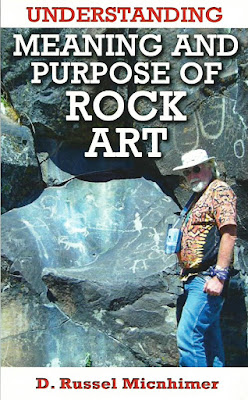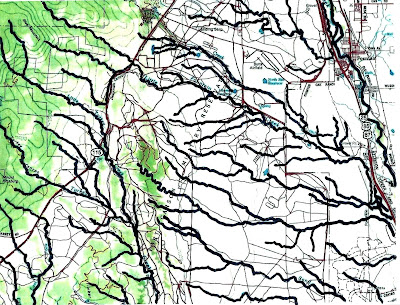Figure 1. 3-Kings Panel, Classic
Vernal Fremont Style, McConkey
Ranch, Utah. Photograph Peter Faris,
September 1994.
The subject of Style in rock art has perhaps engendered more
arguments than any other facet of this field of study. So many people throw the
word style around loosely without actually understanding the definition of that
word. In art studies, style is that suite of defining characteristics which
encompass a group of related works, and separate it from another group. For
instance, Impressionism, as compared to Classicism. But when we look at
Impressionist works by a number of different artists we see a broad range of
appearances between them, so where does style come in? The term Style actually
applies more to the intentions of the artist than it does to the end result of
that artist's creation, but, to the general public, the term becomes applied to
what they see in common from one work to another. That is the basic meaning
of the term Style as it is generally applied in rock art studies.
The rock art in the example of Stylistic Evolution that I am
presenting here began as Fremont Classic Vernal Style figurative imagery as
defined by Polly Schaafsma (1980), and evolved or morphed into what I have
called Post-Classic Vernal Abstraction (Faris 1987:29). Starting with highly
naturalistic examples, why would imagery devolve into increasing abstract forms
over time. My answer is that we have numerous examples from the history of art
in which exactly that has occurred, and I suspect a psychological effect like
"Mere Exposure" is behind it. The basic premise is that people get
used to what they see most often as the way something should be seen - as the
"right way" to portray it.
“THE MORE YOU SEE IT
THE MORE YOU LIKE IT, (Familiarity)
Robert Zajonc (1923-2008) –
Zajonc’s
groundbreaking paper, Attitudinal Effects of Mere Exposure, was
published in The Journal of Personality and Social Psychology in 1968.
Zajonc’s paper describes a series of experiments in which he showed
participants a sequence of random images – geometric shapes, Chinese symbols,
paintings, and pictures of faces – that were flashed in from of them so rapidly
that they were unable to discern which were shown repeatedly. When subjects
were later asked which images they preferred, they consistently chose the ones
to which they had been most frequently exposed, although they were not
consciously aware of the fact. What Zajonc seemed to have discovered was that
familiarity brings about an attitude change, breeding affection or some form of
preference for the familiar stimulus. This increases with exposure: the greater
your number of exposures to something, the more affection you will feel toward
it. To put it simply, 'the more you see it, the more you like it.'” (Collin,
et al 2012:233)
How would that also lead to the evolution (or perhaps
devolution) from realistic to abstracted images? Well, along with the Mere
Exposure effect we humans tend to overlook details, so as we are viewing these
images we are also making subconscious decisions as to which parts of it are
more important than others, and in the future the less important portions of
the image can get overlooked, while the elements we consider to be of greater
importance will remain and perhaps become emphasized.
The Classic Vernal Style of Polly Schaafsma includes figures with attention to realistic details of texture, contour, and accessories, the best example of which is the main figure from the 3-Kings panel at McConkey Ranch, North of Vernal, Utah (FIGURE 1). This ultimate expression of Classic Vernal Style shows anatomic details, clothing and accessory details, and was created in multi-media, painted as well as pecked. Other figures from this stylistic classification are less grand and ornate, but most seem to share this intention toward realism.
This is exactly what I saw in the progression of images from
Cub Creek, Dinosaur National Monument, Utah, a step by step simplification and
abstraction from the Classic Vernal Realism starting point to a final set of
petroglyphs that would not be identified as anthropomorphs if we did not have
the intervening steps to refer to.
Figure 2. Classic Vernal Fremont
Style, McConkey Ranch, Utah.
Peter Faris, 1987.
From the Classic Vernal Style beginning we see a first step
in the evolution of the figure is essentially a simplification. Details of
adornment, headdress, jewelry (pectorals, ear bobs), clothing, etc., are still
present but the figure itself is not realistically proportioned, it reminds one
of a cookie cutter gingerbread man. This example (FIGURE 2), also from McConkey
Ranch in the Dry Fork Valley, near Vernal, Utah, is obviously related to the
3-Kings panel, but not as naturalistically detailed. In effect, the interest is
more in the decorative detail than in the realism of the figure. This focus on
decorative detail will be seen to be a constant throughout the sequence.
Figure 3. Three-Princesses panel at Cub
Creek, Dinosaur National Monument,
Utah. Photograph Peter Faris,
Sept. 1989.
Figure 3A. Close-up of first princess
at Cub Creek, Dinosaur National
Monument, Utah. Photograph
Peter Faris, Sept. 1989.
Figure 3B. Close-up of second and
third princesses at Cub Creek,
Dinosaur National Monument, Utah.
Photograph Peter Faris, Sept. 1989.
As I envisioned it back in 1987, the 3-Kings panel was most
likely created during a cultural peak of the local Fremont culture, after which
the culture slowly changed (or declined), and the rock art changed with it. I
illustrate this with a sequence of anthropomorphs from the great cliff face
site of Cub Creek in Dinosaur National Monument. From the Classic Vernal Style
beginning, the first step in the evolution of the figure is essentially a
simplification. I illustrate this with figures from very near the Cub Creek
cliff face known as the 3-Princesses. the figures now are merely symbolic
shapes instead of realistically proportioned torsos, or even the cookie cutter
figure. FIGURES 3, 3A, and 3B show the 3-princesses panel complete and then
close up, and FIGURES 4 and 5 are drawings of these figures.
Figure 4. First princess at Cub Creek,
Dinosaur National Monument, Utah.
Peter Faris, 1987, page 32.
Figure 5. Second and third princesses
at Cub Creek, Dinosaur National
Monument, Utah. Peter Faris,
1987, page 31.
These figures are stylistically related to the Cub Creek
panels and the location is certainly close enough to be considered as the same
location, and as they are all in the same basic location they were likely to
have been created by one group of people (the local residents) over time, and
thus their changes illustrate perfectly the evolution that I have discussed
above.
This sequence will wait for part 2 of this essay.
REFERENCE:
Collin, Catherine, Nigel Benson, Joannah Ginsburg, Voula
Grand, Merrin Lazyan, and Marcus Weeks,
2012 The Psychology Book, DK Books, London
and New York.
Faris, Peter
1987 Post-Classic
Vernal Abstraction: The Evolution of a Unique Style in Late Fremont Rock Art in
Dinosaur National Monument, Utah, pages 28-40, Southwestern Lore, Vol. 53, No. 1, Colorado Archaeological Society.
Schaafsma, Polly
1980 Indian Rock Art of the Southwest, School
of American Research, Santa Fe, and University of New Mexico Press,
Albuquerque.

























